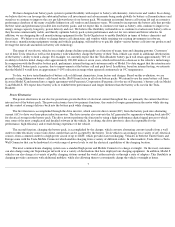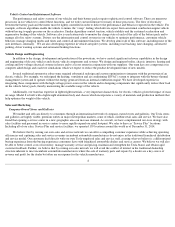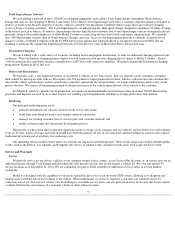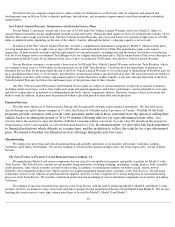Tesla 2015 Annual Report Download - page 18
Download and view the complete annual report
Please find page 18 of the 2015 Tesla annual report below. You can navigate through the pages in the report by either clicking on the pages listed below, or by using the keyword search tool below to find specific information within the annual report.
We may be unable to increase production and deliveries of Model S in line with our plans, both of which could harm our business and
prospects.
Since we began manufacturing and delivering Model S in 2012, we have significantly increased production and deliveries, and our plans
call for an even greater increase in production and deliveries going forward. As part of this effort, we recently completed a new final assembly
line and added more automation to our body shop at the Fremont factory, are installing a highly automated casting and machining operation for
various aluminum components and are finishing the construction of a new high volume paint shop. Our ability to further ramp-up high volume
Model S production, including for the All-Wheel Drive Dual Motor Model S, which we recently began producing for the first time, will depend
upon a number of factors, including our ability to use these new manufacturing processes as planned while maintaining our desired quality
levels, our suppliers’ ability to deliver quality parts to us in a timely manner, and efficiently making design changes to ensure consistently high
quality. To produce a vehicle that meets our quality standards requires us to carefully analyze each step of our production plan, improve the
efficiency of our manufacturing processes and continue to train our employees. Our suppliers also must produce new products in sufficient
quantities and quality to meet our demand. Certain suppliers have experienced delays in meeting our demand or have sought to renegotiate the
terms of the supply arrangements, and we continue to focus on supplier capabilities and constraints. Any disruption in increasing our production
level of Model S in line with our plans could materially damage our brand, business, prospects, financial condition and operating results.
In addition, for Model S we have introduced a number of new manufacturing technologies and techniques, such as aluminum spot welding
systems, which have not been widely adopted in the automotive industry; and the Model S has a number of new and unique design features, such
as a 17 inch display screen, retractable exterior door handles, and all-new dual motor and autopilot hardware, each of which poses unique
manufacturing challenges. Model S production and deliveries will continue to require significant resources and we may experience unexpected
delays or difficulties that could harm our ability to maintain full manufacturing capacity for Model S, or cause us to miss planned production
targets, any of which could have a material adverse effect on our financial condition and operating results. Additionally, sustaining high volume
production and doing so in a manner that avoids significant cost overruns, including as a result of factors beyond our control such as problems
with suppliers and vendors, may be difficult.
Concurrent with the significant increase in our planned production levels, we will also need to continue to significantly increase our
deliveries of Model S vehicles. We have limited experience in delivering a high volume of Model S vehicles, and, in particular, to locations
outside of the United States. We may face difficulties meeting our delivery and growth plans in Asia and the right hand drive markets we have
entered, which may impact our ability to achieve our worldwide delivery goals. If we are unable to ramp up to meet our delivery goals globally
to match our production rate of Model S, this could result in negative publicity, damage our brand and have a material adverse effect on our
business, prospects, financial condition and operating results.
Our ability to grow volume production and deliveries for Model S is subject to certain risks and uncertainties, including:
Finally, detailed long-term testing of quality, reliability and durability of Model S is ongoing and any negative results from such testing
could cause production or delivery delays, cost increases, or lower quality of our Model S vehicles.
17
● that our suppliers will be able and willing to deliver components on a timely basis and in the necessary quantities, quality and at
acceptable prices to produce Model S in volume and reach our financial targets;
1
● that we will be able to complete any necessary adjustments to the vehicle design or manufacturing processes of Model S in a timely
manner that meets our production plan and allows for high quality vehicles;
1
●
that we will be able to fully ramp production of All
-
Wheel Drive Dual Motor Model S to keep up with demand;
1
●
that we will be able to ramp sales of Model S throughout Asia, pursuant to our current timeline;
1
●
that we will be able to adequately respond in a timely manner to any problems that may arise with our vehicles;
1
●
that we will be able to schedule and complete deliveries at our planned higher volume production levels;
1
● that the equipment or tooling which we have purchased or which we select, including those that are part of our higher capacity
production line that recently became operational, will be able to accurately manufacture the vehicle within specified design
tolerances, and will not suffer from unexpected breakdowns or damage which could negatively affect the rate needed to produce
vehicles in volume;
1
● that we will be able to comply with environmental, workplace safety, customs and similar regulations required to operate our
manufacturing facilities;
1
● that we will be able to maintain and improve quality controls as we transition to a higher level of in-house manufacturing process;
and
1
● that the information technology systems that we are currently expanding and improving upon will be effective to manage higher
volume production.
1
























